-
 Bitcoin
Bitcoin $115800
-2.47% -
 Ethereum
Ethereum $3690
1.19% -
 XRP
XRP $3.105
-1.91% -
 Tether USDt
Tether USDt $0.9999
-0.07% -
 BNB
BNB $771.0
0.19% -
 Solana
Solana $179.9
-3.54% -
 USDC
USDC $0.9998
-0.03% -
 Dogecoin
Dogecoin $0.2291
-3.40% -
 TRON
TRON $0.3140
0.81% -
 Cardano
Cardano $0.8007
-1.24% -
 Hyperliquid
Hyperliquid $42.92
-0.44% -
 Stellar
Stellar $0.4212
-2.16% -
 Sui
Sui $3.730
0.03% -
 Chainlink
Chainlink $18.06
0.03% -
 Bitcoin Cash
Bitcoin Cash $546.6
5.08% -
 Hedera
Hedera $0.2438
0.55% -
 Avalanche
Avalanche $23.57
-0.81% -
 Litecoin
Litecoin $114.2
1.04% -
 UNUS SED LEO
UNUS SED LEO $8.970
-0.35% -
 Shiba Inu
Shiba Inu $0.00001363
-0.16% -
 Toncoin
Toncoin $3.136
-0.89% -
 Ethena USDe
Ethena USDe $1.001
-0.04% -
 Uniswap
Uniswap $10.30
1.42% -
 Polkadot
Polkadot $4.013
-0.06% -
 Monero
Monero $324.8
0.87% -
 Dai
Dai $0.9999
-0.04% -
 Bitget Token
Bitget Token $4.509
-1.38% -
 Pepe
Pepe $0.00001226
-2.60% -
 Aave
Aave $291.8
1.34% -
 Cronos
Cronos $0.1294
2.19%
How to operate the monthly MACD top divergence + weekly long upper shadow + daily line shrinking rebound?
Monthly MACD divergence, weekly long upper shadow, and daily shrinking rebound together signal a high-probability bearish reversal in crypto markets.
Jul 24, 2025 at 01:21 pm
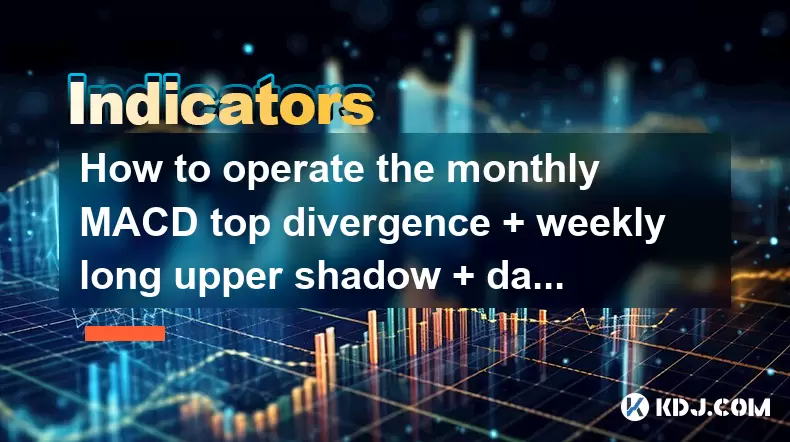
Understanding Monthly MACD Top Divergence
Monthly MACD top divergence occurs when the price of a cryptocurrency reaches a new high, but the MACD indicator fails to confirm this move by forming a lower high. This signals weakening momentum and potential reversal at the monthly timeframe, which is one of the strongest timeframes for trend analysis. To identify this, traders must align their charts to the monthly view and plot the MACD indicator with standard settings (12, 26, 9).
- Open a cryptocurrency charting platform such as TradingView
- Select the asset (e.g., BTC/USDT)
- Change the timeframe to monthly (1M)
- Apply the MACD indicator
- Compare recent price highs with corresponding MACD histogram or signal line peaks
- Confirm divergence if price makes a higher high but MACD makes a lower high
This divergence suggests that bullish momentum is fading, even though price appears strong. It is a warning signal rather than an immediate sell trigger. Traders should not act solely on this signal but use it in combination with other indicators on lower timeframes.
Identifying the Weekly Long Upper Shadow
After confirming monthly divergence, the next step is to analyze the weekly chart for a long upper shadow. A long upper shadow indicates that buyers attempted to push the price higher but were rejected by sellers, often at key resistance levels. This candlestick pattern is particularly significant when it appears after a prolonged uptrend.
- Switch to the weekly (1W) timeframe
- Look for a candle with a significantly long upper wick, ideally at least twice the length of the body
- Ensure the candle closed near its low, indicating strong rejection
- Confirm the shadow formed near a known resistance zone or all-time high
For example, if Bitcoin reaches $75,000 during the week but closes at $70,000 with a long wick up to $76,500, this shows exhaustion. The long upper shadow reflects a failed breakout attempt. This pattern strengthens the bearish case initiated by the monthly MACD divergence. It shows that higher timeframes are aligning to signal a potential trend reversal.
Analyzing Daily Line Shrinking Rebound
Once the higher timeframes suggest weakness, the daily chart (1D) should be examined for a shrinking rebound, also known as a contracting price move following a pullback. This refers to a situation where the price rebounds from a low, but each subsequent candle has a smaller range, indicating diminishing buying pressure.
- Navigate to the daily (1D) chart
- Identify a recent downward correction
- Observe the first few candles of the rebound phase
- Check if the candle bodies are getting smaller and trading ranges are narrowing
- Look for decreasing volume during the rebound
This shrinking rebound suggests that bulls are losing control. Even though the price is moving up slightly, the lack of momentum is concerning. Traders should watch for a bearish engulfing candle or a breakdown below the lowest point of the shrinking candles. This phase acts as a consolidation before a potential resumption of the downtrend.
Combining the Three Signals for Trade Execution
The strategy combines these three elements to increase the probability of a successful short or sell position. The monthly MACD top divergence sets the macro bearish context. The weekly long upper shadow confirms rejection at resistance. The daily shrinking rebound offers a precise entry window.
- Wait for all three conditions to be present
- On the daily chart, place a short entry just below the lowest low of the shrinking rebound candles
- Set a stop-loss above the high of the most recent daily candle
- Use a risk-reward ratio of at least 1:2
- Consider partial profit-taking at previous support levels
For instance, if the shrinking rebound forms between $68,000 and $70,000, and the last candle closes at $68,500 with a small body, a short can be initiated at $68,200 with a stop at $70,200. This setup respects the hierarchy of timeframes and avoids premature entries.
Managing Risk and Position Size
Risk management is critical when trading based on confluence signals. Even strong setups can fail, especially in volatile crypto markets. Each trade should expose no more than 1-2% of total capital.
- Calculate position size based on stop-loss distance
- Use limit orders to enter, avoiding slippage
- Monitor funding rates and open interest on futures platforms
- Avoid trading during major news events or exchange outages
For spot traders, this strategy can be used to take profits or exit long positions rather than shorting. Futures traders should ensure their exchange supports the necessary leverage and has deep liquidity for the chosen asset.
Monitoring Confirmation Candles
After entry, traders must watch for confirmation that the downtrend is resuming. A strong bearish daily candle closing below the shrinking rebound zone adds validity.
- Look for increased downward volume
- Confirm with RSI dropping below 50 on the daily chart
- Watch for breakdowns in key moving averages (e.g., 21-day or 50-day EMA)
- Avoid adding to the position unless new bearish signals appear
If the price stalls or moves sideways, consider closing the trade early to preserve capital. The absence of follow-through selling invalidates the setup.
Frequently Asked Questions
What if the monthly MACD shows divergence but the weekly candle has no upper shadow?
If the weekly chart lacks a long upper shadow, the rejection signal is missing. In this case, the setup is incomplete. Wait for a weekly candle that shows clear selling pressure before considering entry. A neutral or small-bodied candle without a wick does not confirm resistance.
Can this strategy be applied to altcoins?
Yes, but with caution. Major cryptocurrencies like Bitcoin and Ethereum have more reliable chart patterns due to higher liquidity. Altcoins may exhibit erratic candlestick behavior. Always verify that the altcoin has sufficient trading volume and exchange support before applying this method.
How long should I wait for the daily shrinking rebound to form?
There is no fixed duration. The rebound phase typically lasts 3 to 7 daily candles. If the price continues to rise with large bullish candles, the setup is invalid. Only act when the candle ranges visibly contract and momentum slows.
Should I use leverage when shorting based on this setup?
Leverage amplifies both gains and losses. If using leverage, keep it below 3x to avoid liquidation from normal volatility. Never use maximum leverage on a reversal trade, as crypto prices can remain irrational longer than expected.
Disclaimer:info@kdj.com
The information provided is not trading advice. kdj.com does not assume any responsibility for any investments made based on the information provided in this article. Cryptocurrencies are highly volatile and it is highly recommended that you invest with caution after thorough research!
If you believe that the content used on this website infringes your copyright, please contact us immediately (info@kdj.com) and we will delete it promptly.
- Pump, Bonk, Buyback: A Wild Ride in Crypto Town!
- 2025-07-25 19:10:12
- Punisher Coin, Dogecoin, Shiba Inu: Meme Coin Mania in the 2025 Crypto Landscape
- 2025-07-25 19:10:12
- Celestia's Token Control: Buyback & Staking Overhaul in Focus
- 2025-07-25 19:50:11
- Altcoins, Bitcoin, and Crypto Coins: What's Hot in the NYC Crypto Scene?
- 2025-07-25 19:55:52
- Litecoin Price Breakout Imminent? Rally Potential Explored!
- 2025-07-25 17:30:12
- Ether ETFs Surge, Bitcoin Wobbles: Is an ETH Breakout Imminent?
- 2025-07-25 16:50:12
Related knowledge

How to interpret that the KDJ D line is downward for a long time but the price is sideways?
Jul 25,2025 at 07:00pm
Understanding the KDJ Indicator and Its ComponentsThe KDJ indicator is a momentum oscillator widely used in cryptocurrency trading to assess overbough...

What does it mean that the KDJ indicator forms a double bottom at a low level?
Jul 25,2025 at 05:08pm
Understanding the KDJ Indicator in Cryptocurrency TradingThe KDJ indicator is a momentum oscillator widely used in cryptocurrency trading to identify ...
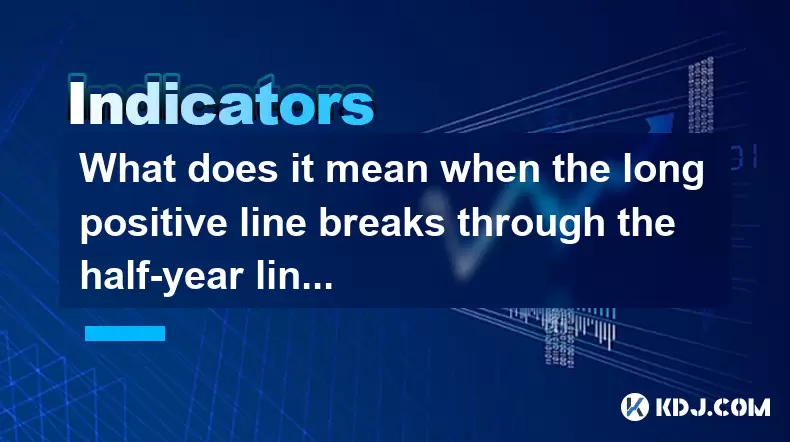
What does it mean when the long positive line breaks through the half-year line and then steps back?
Jul 25,2025 at 06:49pm
Understanding the Long Positive Line in Candlestick ChartsIn the world of cryptocurrency trading, candlestick patterns play a vital role in technical ...
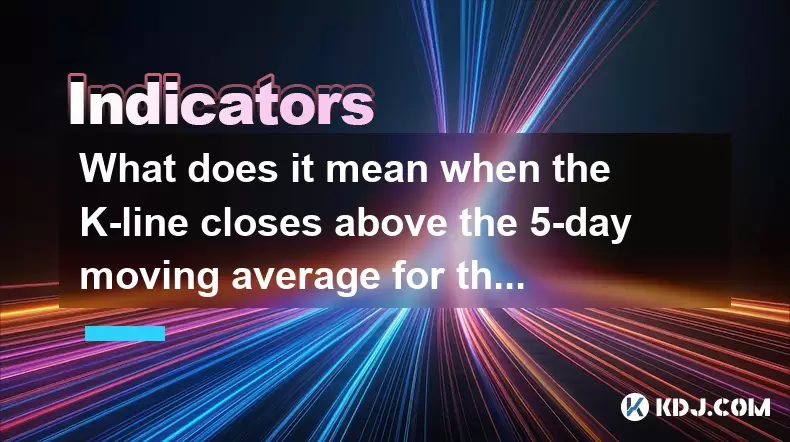
What does it mean when the K-line closes above the 5-day moving average for three consecutive days?
Jul 25,2025 at 10:07pm
Understanding the K-line and 5-day Moving AverageThe K-line, also known as a candlestick, is a critical charting tool used in technical analysis to re...
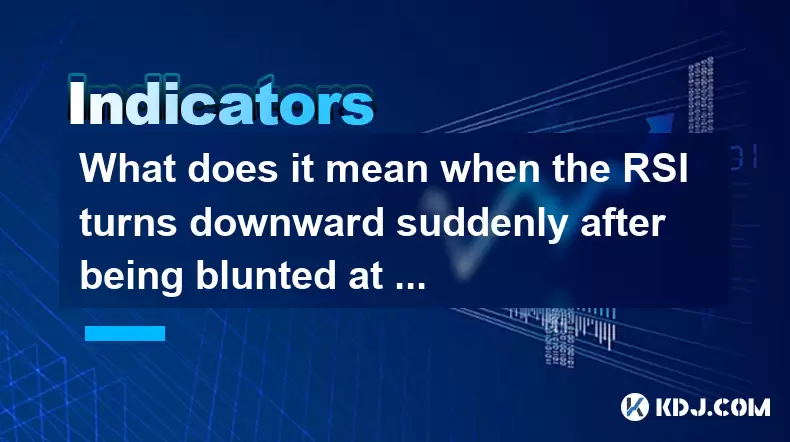
What does it mean when the RSI turns downward suddenly after being blunted at a high level?
Jul 25,2025 at 04:00pm
Understanding the RSI and Its Role in Technical AnalysisThe Relative Strength Index (RSI) is a momentum oscillator that measures the speed and change ...
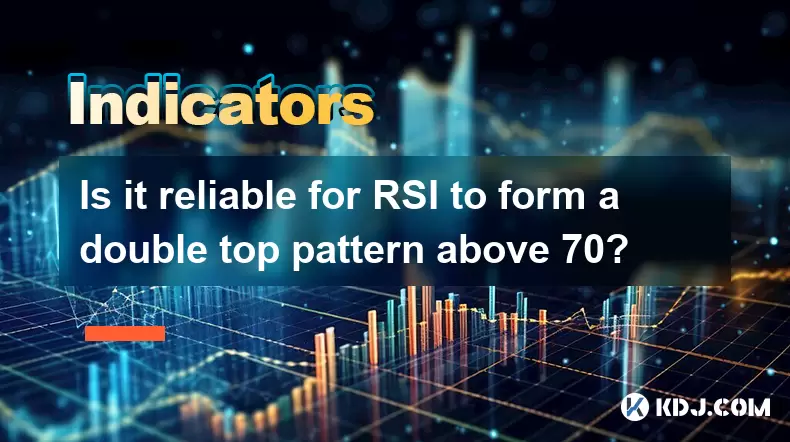
Is it reliable for RSI to form a double top pattern above 70?
Jul 25,2025 at 04:49pm
Understanding the RSI Indicator and Its Role in Technical AnalysisThe Relative Strength Index (RSI) is a momentum oscillator that measures the speed a...

How to interpret that the KDJ D line is downward for a long time but the price is sideways?
Jul 25,2025 at 07:00pm
Understanding the KDJ Indicator and Its ComponentsThe KDJ indicator is a momentum oscillator widely used in cryptocurrency trading to assess overbough...

What does it mean that the KDJ indicator forms a double bottom at a low level?
Jul 25,2025 at 05:08pm
Understanding the KDJ Indicator in Cryptocurrency TradingThe KDJ indicator is a momentum oscillator widely used in cryptocurrency trading to identify ...

What does it mean when the long positive line breaks through the half-year line and then steps back?
Jul 25,2025 at 06:49pm
Understanding the Long Positive Line in Candlestick ChartsIn the world of cryptocurrency trading, candlestick patterns play a vital role in technical ...

What does it mean when the K-line closes above the 5-day moving average for three consecutive days?
Jul 25,2025 at 10:07pm
Understanding the K-line and 5-day Moving AverageThe K-line, also known as a candlestick, is a critical charting tool used in technical analysis to re...

What does it mean when the RSI turns downward suddenly after being blunted at a high level?
Jul 25,2025 at 04:00pm
Understanding the RSI and Its Role in Technical AnalysisThe Relative Strength Index (RSI) is a momentum oscillator that measures the speed and change ...

Is it reliable for RSI to form a double top pattern above 70?
Jul 25,2025 at 04:49pm
Understanding the RSI Indicator and Its Role in Technical AnalysisThe Relative Strength Index (RSI) is a momentum oscillator that measures the speed a...
See all articles

























































































